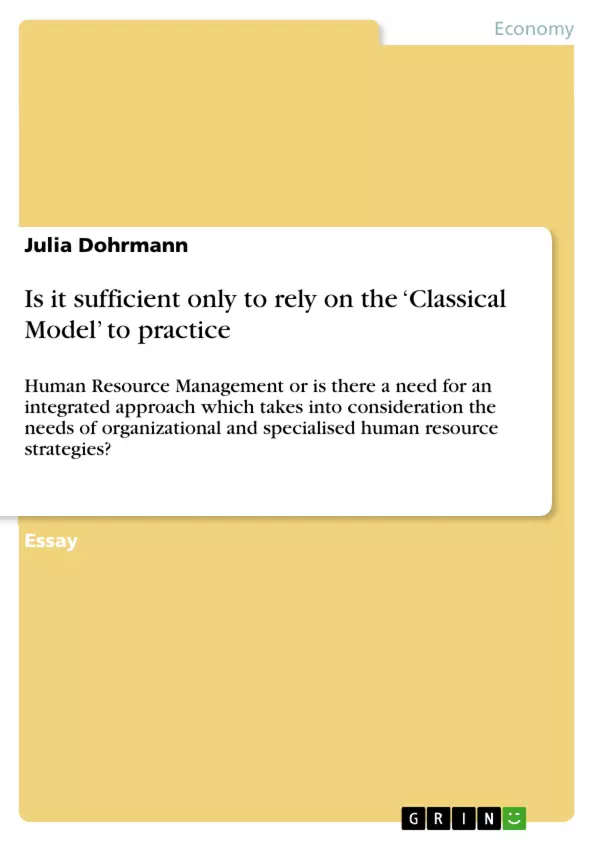In recent years an efficient personnel management became an indisputable fact for success and competitiveness of organizations. Personnel resources emerged to key resources for organizations because the capabilities of employees play a main role in strategic behaviour organizations and in turn cause in an influence of effectiveness of the strategy implementation process. Therefore human resources must become an integral component of the strategic planning process because an effective use of human resources is likely to give an organization a significant competitive advantage. Regarding to Beer, Spector, Lawrence, Quinn Mills and Walton the change in HRM can only be executed “…when general managers develop a viewpoint of how they wish to see employees involved in and developed by the enterprise, and of what HRM policies and practices might achieve these goals. Without either a central philosophy or a strategic view – which can be provided only by general managers – HRM is likely to remain a set of independent activities, each guided by its own practice tradition” (1984, p. 4). For this reason there were pleas for developing HRM to a growing integral strategic dimension, the ‘Strategic Human Resource Management’. As an expansion of HRM it ‘involves’ employees in the strategy formulation process and adjusts HRM to organizational strategy in order to guarantee an efficient strategy implementation (van Donk and Esser, 1992). But SHRM was characterized as an area of difficult definitions and contentious theory.
Due to the described research up-to-dateness of dependency between organizational strategy and HRM the emphasis of this essay is a critical examination if only one model of organizational strategy, the ‘Classical Approach’ is sufficient to practice HRM. By using a confrontation of the understanding and execution of further organizational strategy approaches and specialised HRS models this work attempts to find out if there is a need to have a broad and integrated understanding of these approaches and concepts to practice HRM respectively SHRM. In the following this work will regard to these issues and is going to begin with the definition of certain models of organizational and human resource strategy...
Inhaltsverzeichnis (Table of Contents)
- Cohesion of organizational strategy and human resource management
- Introduction of selected organizational strategy models
- The 'Classical Approach'
- The 'Processual Approach'
- The 'Systemic Approach'
- Introduction of HRS Models for the implementation of SHRM
- The 'Closed Matching Model'
- The 'Open Matching Model'
- Critical evaluation and analysis of the adequacy of the models of organizational strategy and HRS in the economy reality
- Conclusion
Zielsetzung und Themenschwerpunkte (Objectives and Key Themes)
This essay critically examines the effectiveness of relying solely on the 'Classical Approach' to organizational strategy for practicing human resource management (HRM). It aims to determine whether an integrated approach is necessary, taking into consideration the needs of both organizational and specialized human resource strategies.
- The relationship between organizational strategy and HRM
- Different models of organizational strategy, including the 'Classical Approach', 'Processual Approach', and 'Systemic Approach'
- Specialized Human Resource Strategy (HRS) models for implementing Strategic Human Resource Management (SHRM)
- The adequacy of the models in the context of economic reality
- The need for an integrated approach to HRM and SHRM
Zusammenfassung der Kapitel (Chapter Summaries)
- Cohesion of organizational strategy and human resource management: This chapter emphasizes the crucial role of efficient personnel management in achieving organizational success and competitiveness. It highlights the significance of human resources as key resources, recognizing their influence on strategic behavior and strategy implementation effectiveness. The chapter introduces the concept of Strategic Human Resource Management (SHRM) as an integral component of strategic planning and outlines its role in aligning HRM with organizational strategy.
- Introduction of selected organizational strategy models: This section delves into three prominent models of organizational strategy: the 'Classical Approach', 'Processual Approach', and 'Systemic Approach'. Each model is presented, providing an overview of its core principles and application in strategic decision-making.
- Introduction of HRS Models for the implementation of SHRM: This chapter explores two specific HRS models for implementing SHRM: the 'Closed Matching Model' and the 'Open Matching Model'. These models offer practical approaches to aligning human resource practices with organizational goals and strategies.
Schlüsselwörter (Keywords)
The key keywords and focus topics of this essay include organizational strategy, human resource management, Strategic Human Resource Management, 'Classical Approach', 'Processual Approach', 'Systemic Approach', 'Closed Matching Model', 'Open Matching Model', and the relationship between organizational strategy and HRM. The essay explores the relevance and adequacy of these models in the context of economic reality and emphasizes the importance of an integrated approach to HRM and SHRM.
- Quote paper
- Julia Dohrmann (Author), 2008, Is it sufficient only to rely on the ‘Classical Model’ to practice, Munich, GRIN Verlag, https://www.grin.com/document/115243



